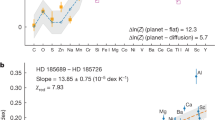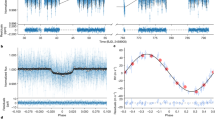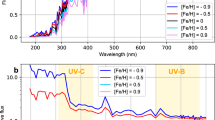Abstract
Stellar members of binary systems are formed from the same material, and therefore they should be chemically identical. However, recent studies have unveiled chemical differences between the two members of binary pairs composed of Sun-like stars. These chemically inhomogeneous binaries represent one of the most contradictory examples in stellar astrophysics and a source of tension between theory and observations. It is still unclear whether the abundance variations are the result of inhomogeneities in the protostellar gas clouds or are due to planet engulfment events that occurred after the stellar formation. The former scenario undermines the general belief that the chemical makeup of stars provides the fossil information of the environment in which they formed, whereas the second scenario would shed light on the possible evolutionary paths of planetary systems. Our study provides compelling evidence in favour of the planet engulfment scenario. We also establish that planet engulfment events occur in Sun-like stars with a 20–35% probability. Therefore, an important fraction of planetary systems undergo very dynamical evolutionary paths that critically modify their architectures, unlike our calm Solar System. This study opens the possibility of using chemical abundances of stars to identify which ones are the most likely to host Solar System analogues.
This is a preview of subscription content, access via your institution
Access options
Access Nature and 54 other Nature Portfolio journals
Get Nature+, our best-value online-access subscription
$29.99 / 30 days
cancel any time
Subscribe to this journal
Receive 12 digital issues and online access to articles
$119.00 per year
only $9.92 per issue
Buy this article
- Purchase on SpringerLink
- Instant access to full article PDF
Prices may be subject to local taxes which are calculated during checkout



Similar content being viewed by others
Data availability
All data generated or analysed during this study are included in this published article as Supplementary Data files.
References
Winn, J. N. & Fabrycky, D. C. The occurrence and architecture of exoplanetary systems. Annu. Rev. Astron. Astrophys. 53, 409–447 (2015).
Mustill, A. J., Davies, M. B. & Johansen, A. The destruction of inner planetary systems during high-eccentricity migration of gas giants. Astrophys. J. 808, 14 (2015).
Pinsonneault, M. H., DePoy, D. L. & Coffee, M. The mass of the convective zone in FGK main-sequence stars and the effect of accreted planetary material on apparent metallicity determinations. Astrophys. J. Lett. 556, L59–L62 (2001).
Cowley, C. R., Bord, D. J. & Yüce, K. Modeling stellar abundance patterns resulting from the addition of earth-like planetary material. Astron. J. 161, 142 (2021).
Chambers, J. E. Stellar elemental abundance patterns: implications for planet formation. Astrophys. J. 724, 92–97 (2010).
Ramírez, I. et al. The dissimilar chemical composition of the planet-hosting stars of the XO-2 binary system. Astrophys. J. 808, 13 (2015).
Spina, L. et al. The Gaia-ESO Survey: chemical signatures of rocky accretion in a young solar-type star. Astron. Astrophys. Lett. 582, L6 (2015).
Teske, J. K., Khanal, S. & Ramírez, I. The curious case of elemental abundance differences in the dual hot Jupiter hosts WASP-94A and B. Astrophys. J. 819, 19 (2016).
Saffe, C. et al. Signatures of rocky planet engulfment in HAT-P-4. Implications for chemical tagging studies. Astron. Astrophys. Lett. 604, L4 (2017).
Spina, L., Meléndez, J., Casey, A. R., Karakas, A. I. & Tucci-Maia, M. Chemical inhomogeneities in the Pleiades: signatures of rocky-forming material in stellar atmospheres. Astrophys. J. 863, 179 (2018).
Tucci-Maia, M., Meléndez, J., Lorenzo-Oliveira, D., Spina, L. & Jofré, P. Revisiting the 16 Cygni planet host at unprecedented precision and exploring automated tools for precise abundances. Astron. Astrophys. 628, A126 (2019).
Nagar, T., Spina, L. & Karakas, A. I. The chemical signatures of planetary engulfment events in binary systems. Astrophys. J. Lett. 888, L9 (2020).
Ramírez, I. et al. The chemical composition of HIP 34407/HIP 34426 and other twin-star comoving pairs. Mon. Not. R. Astron. Soc. 490, 2448–2457 (2019).
Freeman, K. & Bland-Hawthorn, J. The new galaxy: signatures of its formation. Annu. Rev. Astron. Astrophys. 40, 487–537 (2002).
Desidera, S. et al. Abundance difference between components of wide binaries. Astron. Astrophys. 420, 683–697 (2004).
Desidera, S., Gratton, R. G., Lucatello, S. & Claudi, R. U. Abundance difference between components of wide binaries. II. The southern sample. Astron. Astrophys. 454, 581–593 (2006).
Mack, C. E. III, Schuler, S. C., Stassun, K. G. & Norris, J. Detailed abundances of planet-hosting wide binaries. I. Did planet formation imprint chemical signatures in the atmospheres of HD 20782/81? Astrophys. J. 787, 98 (2014).
Liu, F., Asplund, M., Ramírez, I., Yong, D. & Meléndez, J. A high-precision chemical abundance analysis of the HAT-P-1 stellar binary: constraints on planet formation. Mon. Not. R. Astron. Soc. 442, L51–L55 (2014).
Liu, F. et al. Detailed chemical compositions of the wide binary HD 80606/80607: revised stellar properties and constraints on planet formation. Astron. Astrophys. 614, A138 (2018).
Oh, S. et al. Kronos and Krios: evidence for accretion of a massive, rocky planetary system in a comoving pair of solar-type stars. Astrophys. J. 854, 138 (2018).
Reggiani, H. & Meléndez, J. Evidences of extragalactic origin and planet engulfment in the metal-poor twin pair HD 134439/HD 134440. Mon. Not. R. Astron. Soc. 475, 3502–3510 (2018).
Saffe, C. et al. High-precision analysis of binary stars with planets. I. Searching for condensation temperature trends in the HD 106515 system. Astron. Astrophys. 625, A39 (2019).
Hawkins, K. et al. Identical or fraternal twins? The chemical homogeneity of wide binaries from Gaia DR2. Mon. Not. R. Astron. Soc. 492, 1164–1179 (2020).
Andrews, J. J., Chanamé, J. & Agüeros, M. A. Wide binaries in Tycho-Gaia II: metallicities, abundances and prospects for chemical tagging. Mon. Not. R. Astron. Soc. 473, 5393–5406 (2018).
Andrews, J. J. et al. Using APOGEE wide binaries to test chemical tagging with dwarf stars. Astrophys. J. 871, 42 (2019).
Sandquist, E. L., Dokter, J. J., Lin, D. N. C. & Mardling, R. A. A critical examination of Li pollution and giant-planet consumption by a host star. Astrophys. J. 572, 1012–1023 (2002).
Jia, S. & Spruit, H. C. Disruption of a planet spiraling into its host star. Astrophys. J. 864, 169 (2018).
Théado, S. & Vauclair, S. Metal-rich accretion and thermohaline instabilities in exoplanet-host stars: consequences on the light elements abundances. Astrophys. J. 744, 123 (2012).
Spada, F., Demarque, P., Kim, Y.-C., Boyajian, T. S. & Brewer, J. M. The Yale–Potsdam Stellar Isochrones. Astrophys. J. 838, 161 (2017).
Jeffries, R. D. in Stellar Clusters and Associations: Convection, Rotation, and Dynamos Vol. 198 (eds Pallavicini, R. et al.) 245–254 (ASP, 2000).
Carlos, M. et al. The Li–age correlation: the Sun is unusually Li deficient for its age. Mon. Not. R. Astron. Soc. 485, 4052–4059 (2019).
Boesgaard, A. M., Lum, M. G. & Deliyannis, C. P. Correlated depletion and dilution of lithium and beryllium revealed by subgiants in M67. Astrophys. J. 888, 28 (2020).
Bensby, T. & Lind, K. Exploring the production and depletion of lithium in the Milky Way stellar disk. Astron. Astrophys. 615, A151 (2018).
Meléndez, J., Asplund, M., Gustafsson, B. & Yong, D. The peculiar solar composition and its possible relation to planet formation. Astrophys. J. Lett. 704, L66–L70 (2009).
Önehag, A., Korn, A., Gustafsson, B., Stempels, E. & Vandenberg, D. A. M67-1194, an unusually Sun-like solar twin in M67. Astron. Astrophys. 528, A85 (2011).
Gaidos, E. What are little worlds made of? Stellar abundances and the building blocks of planets. Astrophys. J. 804, 40 (2015).
Kunitomo, M., Guillot, T., Ida, S. & Takeuchi, T. Revisiting the pre-main-sequence evolution of stars. II. Consequences of planet formation on stellar surface composition. Astron. Astrophys. 618, A132 (2018).
Mamajek, E. E. Initial conditions of planet formation: lifetimes of primordial disks. AIP Conf. Proc. 1198, 3–10 (2009).
Bedell, M. et al. The chemical homogeneity of Sun-like stars in the solar neighborhood. Astrophys. J. 865, 68 (2018).
Mayor, M. et al. Setting new standards with HARPS. The Messenger 114, 20–24 (2003).
Casali, G. et al. The Gaia-ESO Survey: the non-universality of the age–chemical–clocks–metallicity relations in the Galactic disc. Astron. Astrophys. 639, A127 (2020).
Meléndez, J. et al. 18 Sco: a solar twin rich in refractory and neutron-capture elements. Implications for chemical tagging. Astrophys. J. 791, 14 (2014).
Bedell, M. et al. Stellar chemical abundances: in pursuit of the highest achievable precision. Astrophys. J. 795, 23 (2014).
Ramírez, I., Meléndez, J. & Asplund, M. Chemical signatures of planets: beyond solar-twins. Astron. Astrophys. 561, A7 (2014).
Cox, A. N. Allen’s Astrophysical Quantities (Springer, 2002).
Sneden, C. The nitrogen abundance of the very metal-poor star HD 122563. Astrophys. J. 184, 839–849 (1973).
Epstein, C. R. et al. Chemical composition of faint (I ~21 mag) microlensed bulge dwarf OGLE-2007-BLG-514S. Astrophys. J. 709, 447–457 (2010).
Lindegren, L. et al. Gaia Early Data Release 3. The astrometric solution. Astron. Astrophys. 649, A2 (2021).
Salvatier, J., Wieckiâ, T. V. & Fonnesbeck, C. PyMC3: Python probabilistic programming framework (Astrophysics Source Code Library, 2016).
Asplund, M., Grevesse, N. & Sauval, A. J. The solar chemical composition. Nucl. Phys. A 777, 1–4 (2006).
Wang, H. S., Lineweaver, C. H. & Ireland, T. R. The elemental abundances (with uncertainties) of the most Earth-like planet. Icarus 299, 460–474 (2018).
Acknowledgements
This work has made use of observations collected at the ESO (programmes 188.C-0265, 0103.C-0785 and 0101.C-0275) and of data from the European Space Agency mission Gaia. We are grateful to K. Hawkins, and F. Liu for having shared with us tabular and spectroscopic data. L.S. thanks A. I. Karakas for her support and advice. L.S. also acknowledges financial support from the Australian Research Council (Discovery Project 170100521) and continuing support from the Italian Space Agency through contract 2018-24-HH.0 to the National Institute for Astrophysics (INAF). J.M. thanks FAPESP (2018/04055-8). A.R.C. is supported in part by the Australian Research Council through a Discovery Early Career Researcher Award (DE190100656). M.C. is supported by MIUR under PRIN programme 2017Z2HSMF. Parts of this research were supported by the Australian Research Council Centre of Excellence for All Sky Astrophysics in 3 Dimensions (ASTRO 3D), through project number CE170100013.
Author information
Authors and Affiliations
Contributions
All authors assisted in the development, analysis and writing of the paper. L.S. led and played a part in all aspects of the analysis, and wrote the manuscript. P.S. carried out the spectroscopic analysis of the HARPS sample. J.M. and M.B. contributed in designing this study and in the interpretations of the results. A.R.C. identified the binary pairs with HARPS spectra in the ESO archive and provided the cross-match to the Gaia data set. M.C. and E.F. derived the Li abundances. A.V. contributed to the discussion of the results.
Corresponding author
Ethics declarations
Competing interests
The authors declare no competing interests.
Additional information
Peer review information Nature Astronomy thanks Melinda Soares-Furtado and the other, anonymous, reviewer(s) for their contribution to the peer review of this work.
Publisher’s note Springer Nature remains neutral with regard to jurisdictional claims in published maps and institutional affiliations.
Supplementary information
Supplementary information
Supplementary Figs. 1 and 2, Tables 1–3 and references.
Supplementary Data 1
Full sample of binary pairs. Columns: • Star1 and Star2: name of the two stellar components of the binary system. • teff_ave: average of the Teff derived for the two stars of the binary pair. Unit: Kelvin. • diff_feh: [Fe/H] difference within the pair. • err_diff_feh: uncertainty associated with diff_feh. • Source: reference from which data have been taken.
Supplementary Data 2
HARPS sample. Atmospheric and astrometric parameters. Columns: • Star: name of the star. • RA, DEC: J2000 right ascension and declination. Unit: degrees. • teff, err_teff: Teff and its uncertainty. Unit: Kelvin. • logg, err_logg: logarithm of the surface gravity and its uncertainty. • feh, err_feh: [Fe/H] and its uncertainty. • vt, err_vt: microturbulence and its uncertainty. Unit: km s−1. • Gaia ID, plx, err_plx, pmra, err_pmra, pmdec, err_pmdec: Gaia source_id, astrometric solution and their uncertainties taken from Gaia DR2. Units: parallax is in mas, proper motions in mas yr−1.
Supplementary Data 3
HARPS sample. Chemical abundances relative to the Sun. Columns: • id: name of the star. • [X], err_X, n_[X]: abundance [X/H] relative to the X element, its uncertainty, and number of absorption lines used for the analysis.
Supplementary Data 4
HARPS sample. Differential abundances within the pair. Columns: • star1, star2: name of the two binary components. • [X], err_X, n_[X]: differential abundance [X/H] relative to the X element within the pair, its uncertainty, and number of absorption lines used for the analysis.
Rights and permissions
About this article
Cite this article
Spina, L., Sharma, P., Meléndez, J. et al. Chemical evidence for planetary ingestion in a quarter of Sun-like stars. Nat Astron 5, 1163–1169 (2021). https://doi.org/10.1038/s41550-021-01451-8
Received:
Accepted:
Published:
Issue Date:
DOI: https://doi.org/10.1038/s41550-021-01451-8



